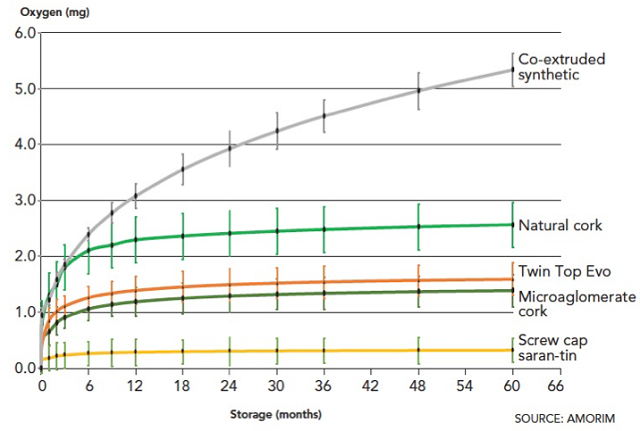Closure contributions to total package oxygen include initial release as well as transmission over time
Figure 1: Introduction of oxygen to bottled wine over time based on closure type (From: Wong 20201)
Oxidation of wine during aging, and evolution of wine in the bottle, depends on the total package oxygen at the time of bottling as well as the oxygen transmission into the bottle after bottling. Different closure types have different initial oxygen release, which contributes to total package oxygen, as well as the oxygen transmission rate during aging.
- Oxygen initial release (OIR) is a major contributor to total package oxygen. Cylindrical closures (natural cork, microaglomerate cork, and synthetic cork) all contain oxygen trapped in the closure material itself that is released in the first few months after bottling. Compression of the closure during insertion creates pressure inside the closure that eventually equilibrates into the headspace. The same open cellular structures that give natural cork its compressibility and elasticity also lead to higher OTR, as these empty spaces contain a lot of oxygen. Other closures that have to be compressed for insertion (microaglomerate and synthetic corks) also show some OIR while screw caps do not introduce much oxygen from this phenomenon2. However, recent bottling audits using new sensory technologies have shown a large variation in TPO introduced at bottling with screwcap closures due to oxygen trapped in the cap itself as it is placed on the bottle, which introduces 2-3 times more oxygen than cork OIR1.
- Oxygen Transmission Rate (OTR) becomes more important after 6-12 months, when the OIR has finished equilibration2,3. Many compounds consume oxygen quickly upon its entry into the wine, so overall DO is not always altered, even when oxygen is added, but new technologies have been developed to better measure this rate2. Once OIR has been equilibrated, natural cork and microaglomerate cork have low rates of transmission that remain steady for several years. The mechanisms that govern oxygen diffusion through the structure of natural cork (leading to OTR) are not well understood2. OTR for natural corks varies based on length and grade. Longer corks have lower OTR. Lower grade corks having higher OTR due to more lenticels1. Synthetic closures have a high transmission of oxygen, which moves relatively easily through the polyethylene plastic, while most screwcaps have very little oxygen transmission, though screwcap liners are now available with higher OTR rates.
After 25-30 years, corks will lose elasticity and begin to leak oxygen between the side of the cork and the bottle, even under good storage conditions1,3. Long term aging under other closures is not very well understood at present.
References
(1) Wong, D. P. Taking Control of Total Package Oxygen. Wine Business Monthly 2020, No. March 2020.
(2) Furtado, I.; Lopes, P.; Oliveira, A. S.; Amaro, F.; Bastos, M. de L.; Cabral, M.; Guedes de Pinho, P.; Pinto, J. The Impact of Different Closures on the Flavor Composition of Wines during Bottle Aging. Foods2021, 10 (9).
(3) A cork closure at the service of your wine. Diam. https://www.diam-closures.com.

